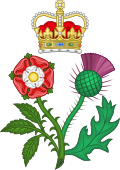The coat of arms of Great Britain was the coat of arms used by the monarchs of the Kingdom of Great Britain, which existed from 1707 to 1801. The kingdom came into being on 1 May 1707, with the political union of the Kingdom of Scotland and the Kingdom of England, which included Wales. The Kingdom of Ireland remained separate, but was represented in the Royal Arms by the harp of Ireland.
On 1 January 1801, the coat of arms was superseded by the coat of arms of the United Kingdom of Great Britain and Ireland, a new kingdom created by the Acts of Union of 1800, which united the kingdoms of Great Britain and Ireland.






